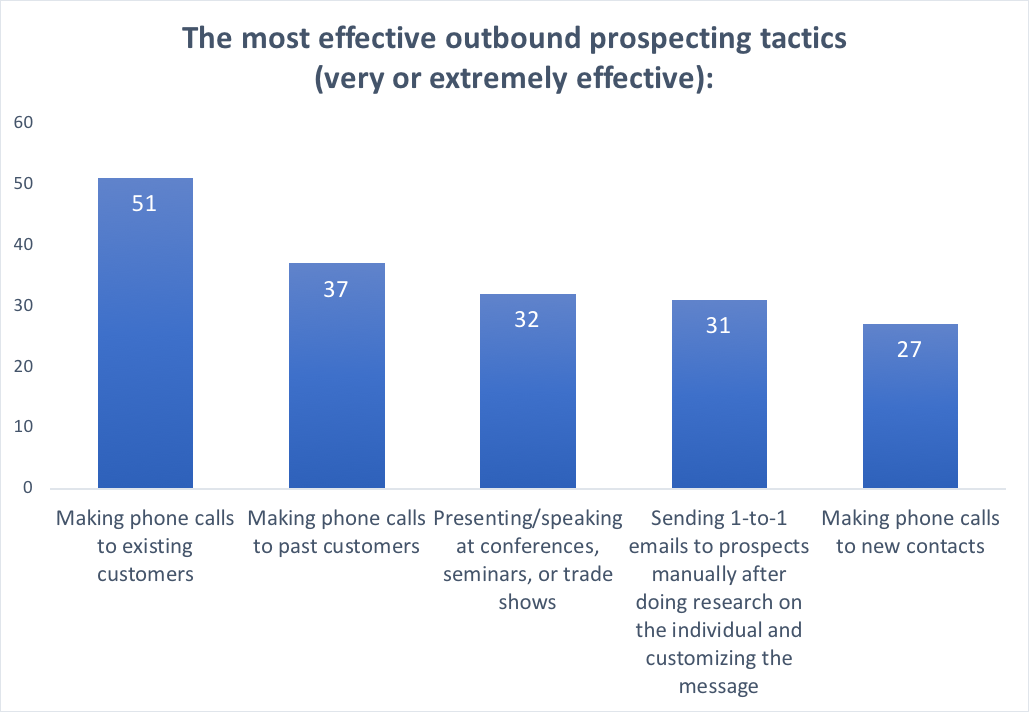
Sellers of technology frequently comment about how impossible it is to get through to technology buyers these days, particularly on the phone.
“Buyers don’t pick up the phone.”
“You can’t get through the gatekeepers.”
“Buyers are too busy.”
Cold calling must be dead.
According to the latest sales prospecting report from the RAIN Group Center for Sales Research, cold calling is one of the most effective ways sellers connect with tech buyers. We studied 488 buyers responsible for $4.2 billion of purchases and 489 sellers. We looked at the results across buyer and seller sets, by industry, and compared buyer and seller responses.
Across the board, we found that the phone and cold calling play a vital role in prospecting, particularly in technology sales.
The reports of the death of cold calling have been greatly exaggerated.
Tech Buyers Prefer to Connect on the Phone
Technology buyers in particular prefer the phone more than buyers in any other industry. Fifty-four percent of tech buyers prefer to connect with sellers on the phone. This is second only to email.
Not only do buyers prefer the phone, it’s one of the top ways sellers actually connect with buyers-70 percent of buyers report that they’ve connect with sellers on the phone.
Sellers Rate the Phone as the Top Prospecting Tactic
Sellers who prospect agree the phone is essential.

Three of the top five most effective ways sellers connect with buyers is on the phone, including making cold calls.
Technology sales has its own set of challenges-it can be a long sales cycle, a competitive sales environment, high-dollar investments with many decision makers involved, and it’s true that tech buyers are busy and receive sales overtures many times a day. Sellers must know how to make the technology case and the business case.
In any case, cold calling can be successful if you do it right.
Most often in technology sales we see sellers fail at cold calling because they’re doing it wrong. There are a million ways to do it wrong and fail. Fail at something enough, and it’s easy to dismiss the whole tactic. (No matter how many times I try, I just can’t hit a Chris Sale fastball. Swinging a bat at a baseball must not work!)
Here are a few key tips to help you become more successful with your efforts.
Research Buyers and Customize Your Message
Buyers report being frustrated with sellers who:
1. Have not researched them on LinkedIn
2. Do not know what their company does
3. Spam them
4. Send obviously generic or automatic-process mail merge emails
These can be remedied with fairly quick research by the seller and customizing your message-whether it’s delivered on the phone, voicemail, or via email-showing that you’ve done your research, know the company, and have looked up the individual you’re reaching out to.
Adjust the Goal of Your Calls
A sale is not the goal of a cold call.
You aren’t going to go from a cold call to a sale in one conversation.
The purpose of a cold call is to set a meeting to introduce yourself and to learn about the buyer or share something of value with them. What type of valuable content are they looking for? Sixty-nine percent of buyers are influenced to accept a meeting or otherwise connect when the provider shares primary research data relevant to the buyer’s business.
The purpose is not to go into a detailed sales pitch.
All too often sellers try to pitch their technology over the phone rather than approaching their buyers with a value based-offer-research, industry insights, or best practices-for an initial meeting.
Bring the Value
In our research-based Six Keys to Prospecting Success, one key factor is: value in every touch.
Let’s assume you’re a CTO at an $800-million manufacturing firm.
Someone calls you and says:
My name is John Smith, and I can help you move your supply chain management to the cloud. Do you need to move to the cloud? Let’s meet.
Even if you’ve thought about moving to the cloud, your immediate needs probably won’t include John Smith.
But let’s say John calls and says:
My name is John Smith. The reason I’m calling is because my company, Cloud Computing, has just recently conducted a major benchmark study on how manufacturing businesses-including Competitor 1 and Competitor 2 of yours-have adopted supply chain management solutions in the cloud and gained strategic advantages. There are three practices that are working across the board and a few common challenges. If you’re interested, we’d be happy to come by and take you through the results.
If this topic is on your mind, you might risk half an hour to hear the results. Or, you might have some questions right during that initial call. Either way, if I’m John, I’ve presented my cold “introduction” of myself and my company to your company in a way that delivers value to you.
Will everyone take you up on this meeting? Of course not. But a certain number will. When you get in front of the buyer, the topic of conversation will be your recent research, work, and expertise-not a “get to know you and sell you” meeting.
Use Multiple Touches and Methods
Cold calling is a powerful tool that should be an integral part of your prospecting efforts, but it shouldn’t be the only part. Fifty-two percent of sellers say it takes between five to 10 touches to connect with a new prospect for the first time. You need an integrated plan that includes multiple outreach methods-phone, email, LinkedIn, direct mail, etc.- and delivers multiple touches over time.
The telephone is a powerful tool in tech sales. Warm or cold, if you learn how to use it well, your chances of success skyrocket.




I think, the ‘bring value’ part is most important (well, perseverance and creativity don’t harm, either).
Why? Because bringing value involves doing some research on the prospect, as a company and an individual. Performing this research makes the call a bit less cold. Jon Ferrara calls this ‘social selling’.